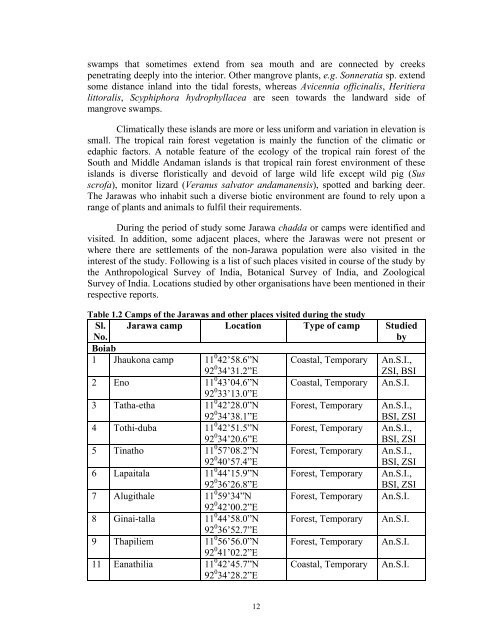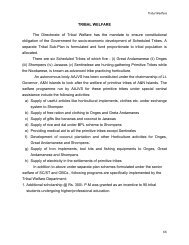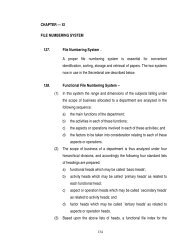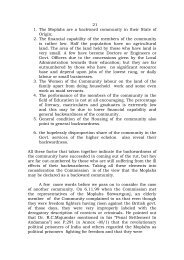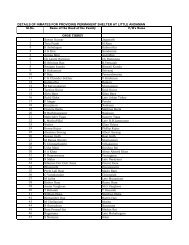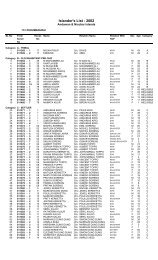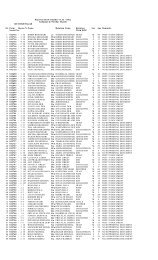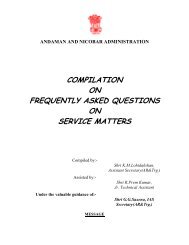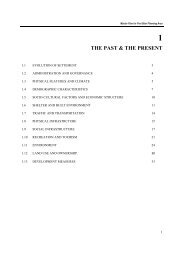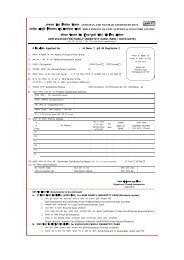1 Introduction - Andaman and Nicobar Islands
1 Introduction - Andaman and Nicobar Islands
1 Introduction - Andaman and Nicobar Islands
You also want an ePaper? Increase the reach of your titles
YUMPU automatically turns print PDFs into web optimized ePapers that Google loves.
swamps that sometimes extend from sea mouth <strong>and</strong> are connected by creeks<br />
penetrating deeply into the interior. Other mangrove plants, e.g. Sonneratia sp. extend<br />
some distance inl<strong>and</strong> into the tidal forests, whereas Avicennia officinalis, Heritiera<br />
littoralis, Scyphiphora hydrophyllacea are seen towards the l<strong>and</strong>ward side of<br />
mangrove swamps.<br />
Climatically these isl<strong>and</strong>s are more or less uniform <strong>and</strong> variation in elevation is<br />
small. The tropical rain forest vegetation is mainly the function of the climatic or<br />
edaphic factors. A notable feature of the ecology of the tropical rain forest of the<br />
South <strong>and</strong> Middle <strong>Andaman</strong> isl<strong>and</strong>s is that tropical rain forest environment of these<br />
isl<strong>and</strong>s is diverse floristically <strong>and</strong> devoid of large wild life except wild pig (Sus<br />
scrofa), monitor lizard (Veranus salvator <strong>and</strong>amanensis), spotted <strong>and</strong> barking deer.<br />
The Jarawas who inhabit such a diverse biotic environment are found to rely upon a<br />
range of plants <strong>and</strong> animals to fulfil their requirements.<br />
During the period of study some Jarawa chadda or camps were identified <strong>and</strong><br />
visited. In addition, some adjacent places, where the Jarawas were not present or<br />
where there are settlements of the non-Jarawa population were also visited in the<br />
interest of the study. Following is a list of such places visited in course of the study by<br />
the Anthropological Survey of India, Botanical Survey of India, <strong>and</strong> Zoological<br />
Survey of India. Locations studied by other organisations have been mentioned in their<br />
respective reports.<br />
Table 1.2 Camps of the Jarawas <strong>and</strong> other places visited during the study<br />
Sl. Jarawa camp Location Type of camp Studied<br />
No.<br />
Boiab<br />
by<br />
1 Jhaukona camp 11 0 42’58.6”N<br />
92 0 Coastal, Temporary An.S.I.,<br />
34’31.2”E<br />
ZSI, BSI<br />
2 Eno 11 0 43’04.6”N<br />
92 0 33’13.0”E<br />
Coastal, Temporary An.S.I.<br />
3 Tatha-etha 11 0 42’28.0”N<br />
92 0 Forest, Temporary An.S.I.,<br />
34’38.1”E<br />
BSI, ZSI<br />
4 Tothi-duba 11 0 42’51.5”N<br />
92 0 Forest, Temporary An.S.I.,<br />
34’20.6”E<br />
BSI, ZSI<br />
5 Tinatho 11 0 57’08.2”N<br />
92 0 Forest, Temporary An.S.I.,<br />
40’57.4”E<br />
BSI, ZSI<br />
6 Lapaitala 11 0 44’15.9”N<br />
92 0 Forest, Temporary An.S.I.,<br />
36’26.8”E<br />
BSI, ZSI<br />
7 Alugithale 11 0 59’34”N<br />
92 0 42’00.2”E<br />
Forest, Temporary An.S.I.<br />
8 Ginai-talla 11 0 44’58.0”N<br />
92 0 36’52.7”E<br />
Forest, Temporary An.S.I.<br />
9 Thapiliem 11 0 56’56.0”N<br />
92 0 41’02.2”E<br />
Forest, Temporary An.S.I.<br />
11 Eanathilia 11 0 42’45.7”N<br />
92 0 34’28.2”E<br />
Coastal, Temporary An.S.I.<br />
12


